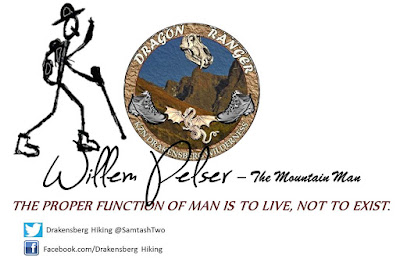“THE VIEW WAS OF A
TRIANGULAR PEAK, SOME TWO THOUSAND FEET ABOVE US, STANDING IN A CLOUDLESS SKY”
GIANT’S CASTLE
On a clear day you can see, from a hilltop in Mooi River (a small farming town in the shadow of the Drakensberg), the Giant’s Castle massif dominating the skyline some seventy kilometers to the west. The image resembles a huge figure lying on its back, staring into the sky, peaceful, silent and contemplative. The Castle itself, which forms the Giant’s head, has three high points, the middle or ‘nose’ being the main summit. This point rises to 3 314 meters, unusually high for a peak set away from the main escarpment wall.
Known to the Zulu people as Bhulihawu, ‘the place of the field thrasher’, or Phosihawu, meaning ‘the shield finger’, the peak is the largest example of a singular mass in the Drakensberg, extending away from the range in an easterly direction for more than three kilometers. The more superstitious called it Ntabayikonjwa, ‘the mountain to which you must not point’, for fear it will retaliate with bouts of violent weather. Owing to its size, the peak’s ability to manipulate the forces of nature on occasion is quite feasible.
When looking up from in its immediate valleys, Giant’s Castle’s main summit takes on a spectacular pyramidal shape, with two sweeping ridges descending to the southeast and north, like great arms embracing the valley below. Many of the earlier climbing routes are found in this area, and a beautifully placed mountain hut waits in the valley, providing a good base from which to start most of the Castle’s technical climbs.
THE PLACE OF VULTURES
Around to the right of this valley extends the mighty north wall. In 1997, one of the most ambitious Drakensberg routes was completed on this enormous precipice. The climb, following an extremely thin weakness, boasts some of the finest and most committing climbing in the Drakensberg range to date, testament to the high level of mountaineering that can be achieved in the area. The route was named after the Bearded Vultures, or Lammergeier (meaning ‘lamb grabber’), that grace the peak’s surrounding skies.
As early as 1941 the peak had been considered as a mountaineering objective, when a climber pioneered a route up the treacherous looking Eastern Gully.
Despite this early interest, face-climbing proper only began when climbers completed what is now considered a classic line up the north face in 1950. The opening of Schole’s Route fired a new interest in the peak as a mountaineering and climbing sanctuary. The establishment of a second route on the north wall in 1971, veering right from the start of Schole’s Route, reasserted the peak’s importance as one of the range’s most challenging mountaineering summits. With routes like Lammergeier and more recently the Land Der Gesetzlosen (‘Land of the Lawless’), the Giant’s north wall is fast becoming a big-wall test piece for southern African climbers.
On the southern slopes, winter mountaineering and ice-climbing developments add a new dimension of challenge on the Giant, offering an aspect of the sport that is often difficult to practice in Africa owing to the warm climate.
The Giant, with its shear faces, particularly its north wall, holds numerous future climbing prospects. The peak is likely to be a focal point in African climbing in the 21st century.
Giant’s Castle is a place of dreams, of staring at the stars by night and the blue skies with white cotton-wool clouds by day.
IT IS A PLACE UNTOUCHABLE BY MAN. IT IS A RESTING PLACE OF GIANTS.
1 – Frontal Route – First Climbed 1955
2 – Schole’s Route – First climbed 1950
3 – Colli Extendenticum – First climbed 1971
4 – South East Ridge – First Climbed 1954
5 – Lammergeier – First Climbed 1997
6 – Land Der Gesetzlosen – First Climbed 1998
We as hikers, explorers, and
adventurers have the absolute duty to respect and protect our Wildernesses.
Nobody else will do it for us. Take ownership!
The End.
Safe Hiking.
Acknowledgements
Extract from the book – Serpent Spires – Duncan Souchon
Photos – Willem Pelser, The Mountain Man.


















